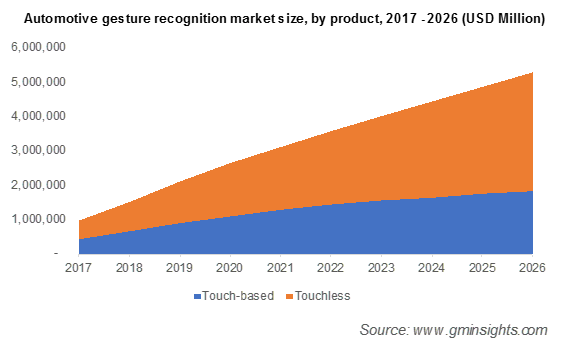Home > Pressrelease > Automotive Gesture Recognition Market worth over $2.5bn by 2026
Automotive Gesture Recognition Market worth over $2.5bn by 2026
- Published Date: March 16, 2020
Automotive Gesture Recognition Market size is set to exceed USD 2.5 billion by 2026, according to a new research report by Global Market Insights Inc.
Increasing accidents owing to driver distraction is generating high demand for gesture recognition systems. According to the WHO, there are over 400,000 road accidents in the world per year owing to external and internal distractions such as using mobile phones. Regulatory authorities have urged automobile manufacturers to adopt innovative solutions to reduce driver distraction and interruptions while driving. This is a key growth driver for the automotive gesture recognition market.
Development of safer Human Machine Interface (HMI) of secondary controls without compromising primary driver functions has posed a challenge for OEMs. A typical vehicle contains around 20 controls including primary and secondary tasks. Prevalent distractors in vehicles include driver controls for mobile phone and music system. The proliferation of additional operations such as seat comfort, navigation and entertainment have further increased potential distractions, requiring the implementation of automotive gesture recognition systems.

Get more details on this report - Request Free Sample PDF
Vision-based automotive gesture recognition market revenue valued at USD 150 million in 2019. Growing technological advancements and the need for security features in vehicles has propelled the interest of consumers and manufacturers towards the installation of advanced systems. For instance, Skoda Vision E vehicles offers advanced gesture control which includes eye tracking for the driver.
Browse key industry insights spread across 216 pages with 190 market data tables and 46 figures & charts from the report, “Automotive Gesture Recognition Market Size By Product (Touch-based, Touchless), By Authentication (Hand/Fingerprint/Palm/Leg, Face, Vision/Iris), By Application (Multimedia/Infotainment/Navigation, Lighting), Industry Analysis Report, Regional Outlook, Growth Potential, Competitive Market Share & Forecast, 2020 – 2026” in detail along with the table of contents:
https://www.gminsights.com/industry-analysis/automotive-gesture-recognition-market
Convenience in operating lighting systems is driving the demand for automotive gesture recognition market
Lighting systems will witness around 17% growth from 2020 to 2026. Gesture control for lighting systems enhances safety as it keeps drivers’ eyes on the road. It provides benefits like greater durability and reliability, as mechanical switches are all but replaced, and lower power operation.
In these types of systems, capacitive switching technology is used in order to detect the gestures as it enters a pre-set field (between 0 and 80 nm). Conductivity of iron in the blood triggers the switch and due to capacitive proximity sensors; gestures are detected even with gloved hands. Automobile manufacturers are enhancing lighting system control by programming the sensors to recognize a sliding or tapping action to dim or change the color of the lights.
Rising luxury and premium car sales in MEA
Rising infrastructure spending, low interest rates and buoyant private sector activities has resulted in luxury and premium cars sales growth in MEA. Saudi Arabia is the largest automobile sector with 50% of total of luxury car sales in the region. The rapid trade and economic expansion are projected to increase new car sales in the country. High GDP per capita, healthy banking sector and increasing public spending has further fueled the market growth. Global automobile manufacturers are expanding their distribution network and production facilities to meet customer demand.
Increasing sales of luxury cars and SUVs owing to rugged terrain and larger family size will boost the automotive gesture recognition market value. The UAE ranks among the top ten countries for premium cars sales such as Ferrari, BMW, and Mercedes. It is estimated that around 3.8 million cars will be sold in the MEA by 2020. The leading brands witnessing high imports include Toyota, Hyundai and Kia. The focus of global automakers to improve the supply chain will further improve the industry share.
Major industry players include Continental AG, Intel, Renesas, Delphi Automotive, Continental AG, Visteon Corporation, Jabil, etc. Companies are forging strategic alliances and improving their research and development activities to offer new solutions and provide enhanced experience, strengthening their market position and gaining a competitive edge.
For instance, in January 2019, Visteon Corporation announced partnership with Tencent Holdings Ltd. The companies are focusing on autonomous driving and intelligent cockpit solutions like gesture control for Guangzhou Automobile Group R&D Center in China. The demand for gesture control is rapidly growing, prompting market players to differentiate their product offerings from the existing products and services.
For instance, in January 2020, Neonode Inc., announced expansion of its touch sensors product line. The new sensor modules are available in nine lengths, to support interaction areas from 3” to 16” diagonally. It enables new levels of design freedom and allows integration in a wider range of applications.
Explore More on Related Topics:
Infographics
